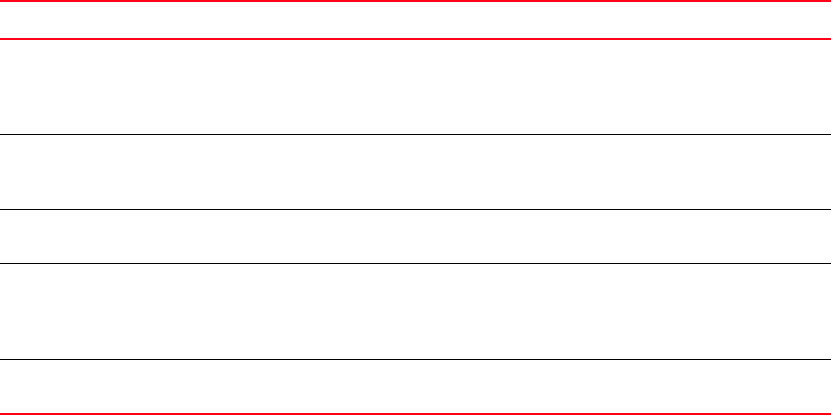Brocade Converged Enhanced Ethernet Administrator's Guide v6.1.2_cee (53-1001258-01, June 2009)
Table Of Contents
- Contents
- Figures
- Tables
- About This Document
- Introducing FCoE
- Using the CEE CLI
- In this chapter
- CEE CLI configuration guidelines and restrictions
- Using the CEE command line interface (CLI)
- CEE CLI RBAC permissions
- Accessing the CEE CLI through the console interface or through a Telnet session
- Accessing the CEE CLI from the Fabric OS shell
- Accessing CEE CLI command modes
- Using CEE CLI keyboard shortcuts
- Displaying CEE CLI commands and command syntax
- Using CEE CLI command completion
- CEE CLI command syntax conventions
- Using CEE CLI command output modifiers
- Configuring VLANs Using the CEE CLI
- In this chapter
- VLAN overview
- Ingress VLAN filtering
- VLAN configuration guidelines and restrictions
- Default VLAN configuration
- VLAN configuration procedures
- Enabling and disabling a CEE interface
- Configuring the MTU on a CEE interface
- Creating a VLAN interface
- Configuring a VLAN interface to forward FCoE traffic
- Configuring a CEE interface as a Layer 2 switch port
- Configuring a CEE interface as an access interface or a trunk interface
- Configuring VLAN classifier rules
- Configuring VLAN classifier groups
- Associating a VLAN classifier group to a CEE interface
- Clearing VLAN counter statistics
- Displaying VLAN information
- Configuring the MAC address table
- Configuring STP, RSTP, and MSTP using the CEE CLI
- In this chapter
- STP overview
- RSTP overview
- MSTP overview
- STP, RSTP, and MSTP configuration guidelines and restrictions
- Default STP, RSTP, and MSTP configuration
- STP, RSTP, and MSTP configuration procedures
- STP, RSTP, and MSTP-specific configuration procedures
- STP and RSTP-specific configuration procedures
- RSTP and MSTP-specific configuration procedures
- MSTP-specific configuration procedures
- 10-Gigabit Ethernet CEE interface-specific configuration
- Global STP, RSTP, and MSTP-related configuration procedures
- Clearing STP, RSTP, and MSTP-related information
- Displaying STP, RSTP, and MSTP-related information
- Configuring Link Aggregation using the CEE CLI
- Configuring LLDP using the CEE CLI
- Configuring ACLs using the CEE CLI
- In this chapter
- ACL overview
- Default ACL configuration
- ACL configuration guidelines and restrictions
- ACL configuration procedures
- Creating a standard MAC ACL and adding rules
- Creating an extended MAC ACL and adding rules
- Modifying a MAC ACL
- Removing a MAC ACL
- Reordering the sequence numbers in a MAC ACL
- Applying a MAC ACL to a CEE interface
- Applying a MAC ACL to a VLAN interface
- Clearing MAC ACL counters
- Displaying MAC ACL information
- Configuring QoS using the CEE CLI
- Configuring FCoE using the Fabric OS CLI
- Administering the switch
- Configuring RMON using the CEE CLI
- Index

Converged Enhanced Ethernet Administrator’s Guide 63
53-1001258-01
STP, RSTP, and MSTP configuration procedures
4
Disabling or enabling spanning tree
From the CEE interface, use this command to disable or enable spanning tree on the CEE interface.
To disable or enable spanning tree on the CEE interface, perform the following steps:
Global STP, RSTP, and MSTP-related configuration procedures
In this section
•Flushing MAC addresses. . . . . . . . . . . . . . . . . . . . . . . . . . . . . . . . . . . . . . . . . 63
Flushing MAC addresses
For RSTP and MSTP, use this command to flush the MAC addresses from the VLAN filtering
database (FDB). The VLAN FDB determines the forwarding of an incoming packet. The VLAN FDB
contains information that helps determine the forwarding of an arriving frame based on MAC
address and VLAN ID data (see “VLAN configuration guidelines and restrictions” on page 27).
There are two ways to flush the MAC addresses:
• Standard method—When one port receives a BPDU packet with a topology change flag, it
flushes the FDB for the other ports in the switch. If a BPDU packet with the topology change
flag is received continuously, the switch continues to flush the FDB. This behavior is the default
behavior and is activated by entering the spanning-tree tc-flush-standard command.
• Brocade method—To avoid the continuous flushing that you get with the standard method,
enter the no spanning-tree tc-flush-standard command. With this method, the FDB is only
flushed for the first and last BPDU that has a topology change flag.
Both methods flush the FDB when the switch receives BPDUs with a topology change flag, but the
Brocade method causes less flushing.
Step Task Command
1. Enter global configuration mode. switch>#config t
Enter configuration commands, one
per line. End with CNTL/Z.
switch(config)#
2. Specify the CEE interface (interface 0/1 is used in
this example).
switch(config)#interface
tengigabitethernet 0/1
switch(conf-if-te-0/1)#
3. Enable the CEE interface. switch(conf-if-te-0/1)#no shutdown
switch(conf-if-te-0/1)#
4. Disable or enable spanning tree on the CEE
interface. By default, spanning tree is disabled. Use
the no spanning-tree shutdown command to enable
spanning tree on the CEE interface.
switch(conf-if-te-0/1)#spanning-tree
shutdown
5. Display the spanning-tree configuration. switch(conf-stp)#do show
spanning-tree










